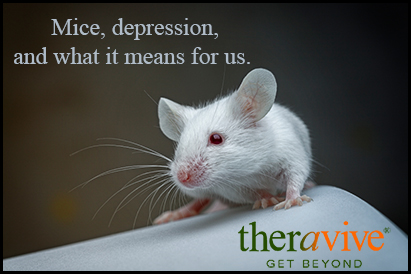 Studies have shown that depression-like behavior in mice correlates with abnormal electrical activity in the brain. By modulating these electrical signals, researchers have fixed the brains of these mice and returned their behavior to normal.
Studies have shown that depression-like behavior in mice correlates with abnormal electrical activity in the brain. By modulating these electrical signals, researchers have fixed the brains of these mice and returned their behavior to normal.
Balance in the Brain
Researchers did not attempt to suppress abnormal electrical activity in depression-susceptible mice. Instead, scientists funded by the National Institutes of Health (NIH) increased the strange activity in the brain cells even more. This led to a self-stabilization of the activity. Re-establishment of this balance caused the susceptible animals to no longer show signs of stress (listlessness, withdrawal, and anxiety) following a socially stressful experience (Friedman, et al., 2014).
Scientists were startled to find that cells in the brain have an inborn ability to modulate their electrical signals back at a more normal pattern. Ming-Hu Han, PhD, works at the Icahn School of Medicine at Mount Sinai, New York City, a grantee of the NIH’s National Institute of Mental Health (NIMH). He led the team of researchers at Mount Sinai. The work was published in April of 2014 in the journal Science.
Why This is Important
The director of the NIMH, Thomas Insel, MD, believes that this kind of study will help solve mysteries surrounding depression. By better understanding how depression works, new anti-depressant drugs can be developed that will take advantage of this resilience mechanism.
Special mice, developed specifically for these studies, come in two types. The normal mice are resilient after exposure to social stress. Stress-susceptible mice, in contrast, show depression-like behavior after exposure to social stress.
Some electrical pathways in the brains of mice are involved in the rewards center of the brain. Researchers chose to study these centers in mice exposed to social stress. For mice, this means repeated encounters with a dominant animal. Some mice emerge from these repeated encounters unscathed while other mice develop depression-like behavior (Cao, et al, 2010 and Tateno & Robinson, 2011).
One way cells within the brain communicate with each other is with chemicals called neurotransmitters. One neurotransmitter in brains is called dopamine. An increase in dopamine levels means an increase in activity levels (Roeper, 2013).
Comparing different areas of the brain between mice that were resilient to social stress and mice that were susceptible, scientists found that a specific area of their brains had different levels of activity. Normally, one would expect the extra activity to be linked with the stress-susceptible mice. Han and her colleagues were surprised to find that the resilient mice had higher levels of excitability by increasing the release of dopamine. But conversely, the same cells in the brain also increase inhibitory signals, thus, “self-balancing” themselves.
Han and co-workers hypothesized that in resilient animals the excitatory signal triggered an increase in the inhibitory signal, resulting in a balancing of the signals and normal behavior. So maybe all the susceptible mice needed was a boost in activity become resilient.
 The Experiment
The Experiment
Han’s team added a medicine to increase activity in susceptible mice for five days. When the mice were exposed to social stress, they acted like resilient mice with normal behavior.
When researchers looked at the treated mice on the cellular level, both inhibitory and excitatory pathways were increased, resulting in a return to normal activity. The medicine the mice received, lomatrigine, is employed as a mood stabilizer in people in the depressed phase of bipolar disorder. This work may have just established precisely how this drug works.
It is counterintuitive that stimulating already abnormally excited areas in the brain would cause the brain to generate another inhibitory effect. That is what makes this discovery so exciting. The brains of these susceptible mice needed only extra stimulation to generate a response that returned the mouse brains to normal.
Balancing two different mechanisms to finely regulate something in biology is referred to as homeostasis. Many other things in the body use homeostasis to maintain a balance such as blood pressure, heart rate, and body temperature.
_________________________________________________________________________________________________________________________________
Cao J., Covington H., Friedman A., Wilkinson M., Walsh J., Cooper D., Nestler E., Han M. 2010. Mesolimbic dopamine neurons in the brain reward circuit mediate susceptibility to social defeat and antidepressant action. Journal of Neuroscience; 30(49):16453-8.
Chaudhury D., Walsh J., Friedman A., Juarez B, Ku S., Koo J., Ferguson D., Tsai H., Pomeranz L., Christoffel D., Nectow A., Ekstrand M., Domingos A., Mazei-Robison M., Mouzon E., Lobo M., Neve R., Friedman J., Russo S., Deisseroth K., Nestler E., Han M. 2013. Rapid regulation of depression-related behaviours by control of midbrain dopamine neurons. Nature; 493(7433); 532-6.
Friedman A., Walsh J., Juarez B,. Ku S., Chaudury D., Wan J., Li X., Dietz D., Vialou V., Neve R., Yue A., Han M-H. 2014. Enhancing depression mechanisms in midbrain dopamine neurons achieves homeostatic resilience. Science, 344 (6181); 313-319.
Roeper J. 2013. Dissecting the diversity of midbrain dopamine neurons. Trends in Neuroscience; 36(6):336-42.
Tateno T., Robinson H. 2011. The mechanism of ethanol action on midbrain dopaminergic neuron firing: a dynamic-clamp study of the role of I(h) and GABAergic synaptic integration. Journal of Neurophysiology; 106(4):1901-22.